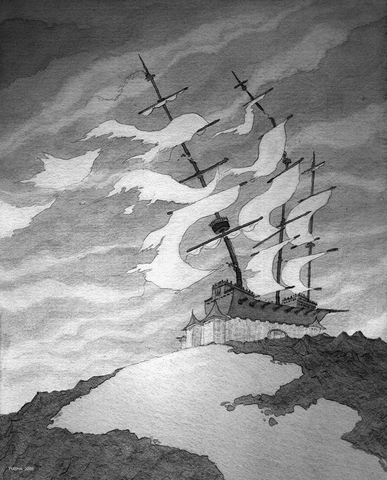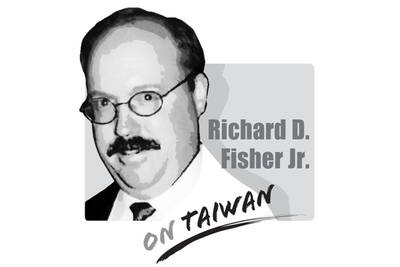We all know that a lie goes halfway round the world while truth is putting on its boots. But what if the lie goes the whole way? What if it claims to circumnavigate the globe?
Purported evidence that the Chinese admiral Zheng He (
The map challenges the customary Euro-centric version of global discovery and can thus rely on a weight of political correctness in support. It appears to stake China's claim to have "discovered" America first.

This comes as a surprise to those of us who know for a fact that America was discovered by Prince Madoc ab Owain Gwynedd in 1170. He landed at Mobile, Alabama, on the orders of the family druid and asserted Wales' claim to King Arthur's North Atlantic empire. Making his way across country, he settled west of the Mississippi, where the Mandan tribe were encountered in the 18th century, fair skinned and speaking a dialect of Welsh.
Unfortunately, Madoc's arrival had been forestalled by St Brendan in the seventh century. He sailed to America in a leather-bound coracle, as Tim Severin proved in 1977. The survivors of this trip remain pickled in a downtown Boston saloon to this day.
Brendan and Madoc were followed by a Scottish knight templar, Henry Sinclair, seeking refuge from the suppression of his order in 1398. He and his freemasons escaped with assorted treasures and holy grails to settle in Nova Scotia with the Micmac Indians (clearly a tribe of Hiberno-Scots ancestry). Sinclair's masonic star, or "la merika," duly gave its name to the continent and merits a Da Vinci saga all of its own.
The only blot on this glory is that everyone knows America got its name from Glamorgan's Richard ap Meurig (Amerik), a wealthy sponsor of John Cabot's search for the north-west passage in the 1490s.
It is amazing that all these chaps never bumped into each other. Sailors tend to chat, and nothing obsesses them so much as maps.
Zheng's giant ships -- some 122m long, five times the size of Columbus' -- would surely have left a chopstick or two in Manhattan.
They would have left more than a kung fu parlor in downtown LA. As for Zheng He's dubious British cheerleader, the author Gavin Menzies, how can he explain a detailed Chinese map of America appearing three years before his hero discovered the place, as he claims, in 1421?
The Chinese map is plainly a hoax. It not only shows North and South America as massive continents, which no sailor could possibly have known. It accurately depicts Alaska, the curve of central America and the Yucatan peninsula, not to mention the Mississippi and St Lawrence rivers. It shows Australia and the land mass of Antarctica beneath it, and New Zealand as two islands.
Even normally chauvinistic Chinese scholars have rubbished the find. They pointed out last week that the cartographic portrayal of the Earth as two circles on a flat sheet is European. The most obvious "mistake," showing California as an island, is clearly borrowed from mistakes made in 17th-century European maps.
Nor are the Chinese characters properly medieval, that for the western God postdating the arrival of Jesuit missionaries. Zheng He's 15th-century travels in the Indian Ocean were indeed sensational, but they were well authenticated. Why diminish them by faking a circumnavigation? Besides, since the map is a copy, there is no way of verifying any original.
I blame the Internet. It is an open house for boosting the egos of crackpot historians, though it does at least facilitate their demolition. Map hoaxers usually fall down not on their inaccuracy but on their accuracy. It was the correctness of the 1440 Vinland map's outline of Greenland that for many years queried its status as the first map to show North America (or at least Baffin Island). Only after much scholarship in the 1960s was its authenticity put beyond doubt. As the Vinland scholar RA Skelton asserted at the time, it remains "the only known cartographic delineation of American lands before the discoveries of Columbus and Cabot."
The Vinland map's historical origin lay in the first known settlement of modern America by outsiders, by the Viking Leif Eriksson in the early 11th century. It is described in the sagas, and archaeological remains survive at L'Anse aux Meadows in Newfoundland.
Since Columbus is thought to have sailed with Bristolians (people from the port city of Bristol in western England) to Iceland and cited "the lands the Bristol captains know" in support of his own expedition, Bristol's claim to the first "discovery" of America since the Vikings remains strong.
Yet so what? As theoreticians of geography point out, it all depends what you mean by discovery. America was "found" by Siberian migrants across the Bering Strait at various times between the 30th and the 10th millennium BC. As for later contacts, a minor industry surrounds the likelihood of Phoenicians, Portuguese and other sailors being blown across the Atlantic before Columbus and never coming back. African and Brazilian rafts may have drifted back and forth carrying seeds, spores and genes with them. That Chinese or other Oriental sailors may have travelled down the coast of Canada is possible. The trouble is, they never told us so.
Discovery requires more than a verifiable fact. It requires understanding what has been discovered, being able to place this mountain, island or coast in a framework of knowledge. That is why skeptics were right to question Columbus as the "discoverer" of America, since to his dying day he was convinced he had reached part of Asia. The real discoverer was Amerigo Vespucci, whose later voyages revealed the new continent for what it was, and from whom it took its name.
Hence Daniel Boorstin's masterpiece of modern geography, The Discoverers, presented the Portuguese Prince Henry the Navigator as a true explorer, merely sitting in his Sagres castle at Cape St Vincent, debriefing his captains and filling the blanks on his maps.
When Europeans heard tell of the New World, they were disappointed to be told by Columbus that "in these islands I have so far found no human monstrosities, as many expected." It was the disappointment of imagination corrected by facts.
Such discoverers were map makers not just of place, but of science, society, economics, the human body and the human mind. In the person of Einstein, Boorstin finally found geography married to physics, "when time and space came together in a single tantalizing riddle." All scientists were geographers at heart. That is why maps are the most sacred tools of science. That is why those who fabricate and abuse them are a menace to the cause of knowledge.

On Sept. 3 in Tiananmen Square, the Chinese Communist Party (CCP) and the People’s Liberation Army (PLA) rolled out a parade of new weapons in PLA service that threaten Taiwan — some of that Taiwan is addressing with added and new military investments and some of which it cannot, having to rely on the initiative of allies like the United States. The CCP’s goal of replacing US leadership on the global stage was advanced by the military parade, but also by China hosting in Tianjin an August 31-Sept. 1 summit of the Shanghai Cooperation Organization (SCO), which since 2001 has specialized
In an article published by the Harvard Kennedy School, renowned historian of modern China Rana Mitter used a structured question-and-answer format to deepen the understanding of the relationship between Taiwan and China. Mitter highlights the differences between the repressive and authoritarian People’s Republic of China and the vibrant democracy that exists in Taiwan, saying that Taiwan and China “have had an interconnected relationship that has been both close and contentious at times.” However, his description of the history — before and after 1945 — contains significant flaws. First, he writes that “Taiwan was always broadly regarded by the imperial dynasties of
The Chinese Communist Party (CCP) will stop at nothing to weaken Taiwan’s sovereignty, going as far as to create complete falsehoods. That the People’s Republic of China (PRC) has never ruled Taiwan is an objective fact. To refute this, Beijing has tried to assert “jurisdiction” over Taiwan, pointing to its military exercises around the nation as “proof.” That is an outright lie: If the PRC had jurisdiction over Taiwan, it could simply have issued decrees. Instead, it needs to perform a show of force around the nation to demonstrate its fantasy. Its actions prove the exact opposite of its assertions. A
A large part of the discourse about Taiwan as a sovereign, independent nation has centered on conventions of international law and international agreements between outside powers — such as between the US, UK, Russia, the Republic of China (ROC) and Japan at the end of World War II, and between the US and the People’s Republic of China (PRC) since recognition of the PRC as the sole representative of China at the UN. Internationally, the narrative on the PRC and Taiwan has changed considerably since the days of the first term of former president Chen Shui-bian (陳水扁) of the Democratic